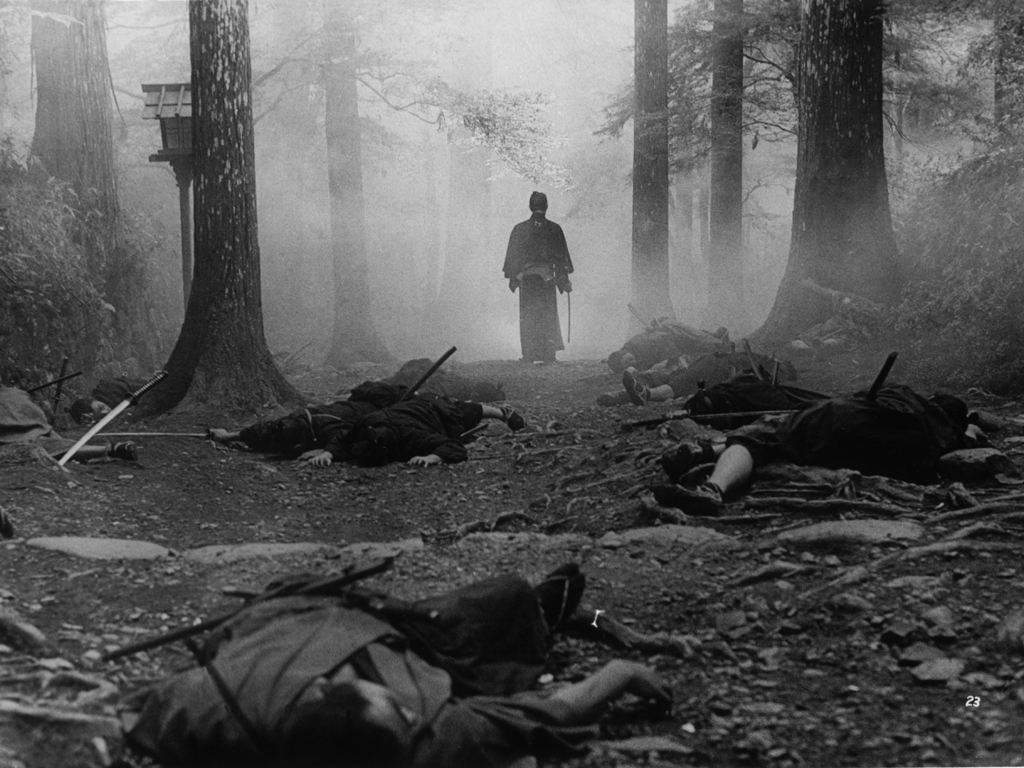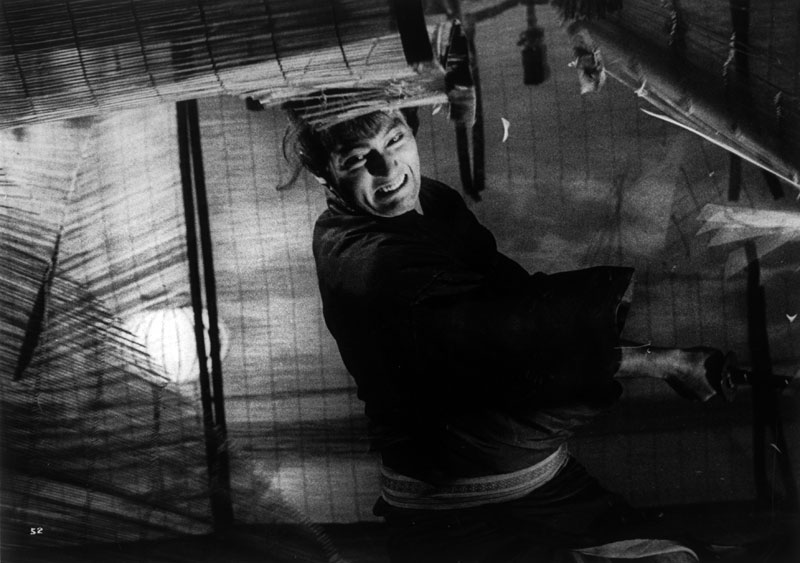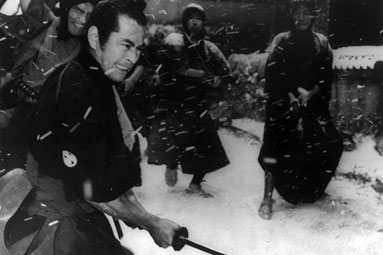
I try to approach movies as tabula rasa as possible. You know, a general understanding of genre and plot, perhaps, no more than you would get from your average video box. That’s part of watching a good movie for the first time; the Discovery Phase, keeping up with the characters, the twists and turns of the plot. Hell, one of my best evenings was going to a sneak preview of John Sayles’ MATEWAN, when we only know the name of the movie, period.
Sometimes, though, that blissful ignorance can work against you.
SWORD OF DOOM is a very well-regarded samurai flick. 8 out of 10 at the Internet Movie Database, two different releases from Criterion. This was literally all I needed to know going in.

SWORD OF DOO is the tale of Ryunosuke Tsukue (a marvelous performance by Tatsuya Nakadai), an extraordinary swordsman, and also apparently an unremittingly evil one. At the movie’s beginning, Ryunosuke comes across an aged Buddhist pilgrim at a roadside shrine, praying for death so he will no longer be a burden on his young daughter. Ryunosuke obligingly kills him on the spot without batting an eyelash. A traveling peddler almost meets the same fate, but is too swift, running away before the disinterested Ryunosuke can slash again. The peddler then finds the old man’s daughter sobbing over the corpse.
Ryunosuke is fighting a duel the next day, with a samurai who, if he wins, will become a fencing master at the school Ryunosuke abandoned; his ailing father begs him to let the man win, and despairs of the fighting style his son has developed, a “cruel style” which draws in the opponent and dispatches him quickly, like a snake striking. He feels the cruelty of the form has taken over his son’s life. This may be true, as that evening, his opponent’s wife arrives to beg Ryunosuke to let him win, and out black-clad anti-hero forces her to give up her body in a decrepit river mill to seal the deal.

The husband gets wind of this however, and the match becomes a duel to the death. This becomes obvious to everyone witnessing this match, the fencing masters as well as the audience, before a blow is even struck. The referee qucikly calls a draw, but the husband launches an illegal attack, deftly parried by Ryunosuke, who instantly kills the man… with one blow from a wooden sword. Ryunosuke then leaves town, the widow in tow, while dispatching about twenty clansmen seeking revenge on a country road.
Two years pass, Ryunosuke fathers a child with the widow, and what seemed quiet insanity in the nihilistic samurai becomes slowly more overt as he falls in with a group of pro-Shogunate swordsmen who advance their cause through assassination, letting Ryunosuke handle the tougher targets. Concurrent with this, we find that his dueling victim’s brother is searching for him, and, on advice of Ryunosuke’s own dying father, has begun taking lessons from famed fencing instructor Toranosuke Shimada (Toshiro Mifune) to defeat Ryunosuke’s Silent style.

All this comes to a head in a party house in Kyoto, where, in a supposedly haunted room, Ryunosuke discovers that the courtesan he is supposed to kill (to keep silent about a plan to murder the head of his gang) is actually the daughter of the old man he killed at the beginning of the movie. This what finally seems to break the hard-drinking samurai, as he sees the shadows of people he has killed in the corners of the room and goes berserk, slashing at the many screens on which the shadows appear. A counterplot to kill Ryunosuke and his co-conspirator interrupts his screen-slashing, and Ryunosuke spends the rest of the picture cutting his way through a seemingly unending throng of swordsmen, who, through sheer force of numbers, manage to wound him enough to slow him down, until the movie ends in a freeze-frame, Ryunosuke in mid-slash.
Here is where the ignorance works counter to your enjoyment. There are several well-developed plot threads left unresolved by this ending, and any uneducated gaijin like myself is going to find himself hell of bewildered. Earlier in the week I had Tweeted that I loved Criterion for continuing to rock the pack-in booklet on its releases, and this one, an essay by Geoffrey O’Brien, provided me everything I needed to know, mainly this is the first movie in a trilogy that never got finished.
Based on one of those outlandishly complex serialized novels so popular in Asia, Dai-bosatsu toge – left unfinished at 41 volumes by the death of its author, Kaizan Nakazato – SWORD OF DOOM is apparently a Greatest Hits version of the first third of the series, very familiar to the Japanese audience of the time. There had already been three movie versions of the novel by this time, two of which were trilogies.
But all we have right now is SWORD OF DOOM, so let’s examine it. It is a beautifully well-made movie (which makes its unfinished qualities more frustrating), with strong performances across many interesting, complex characters. The two formal fencing matches, the first the duel at the begiing, the second a match between Ryunosuke and, unwittingly, the vengeful brother, are marvelously presented, the two fencers standing in silence for what seems an eternity. The counter-intuitive nature of Ryunosike’s silent style, sword down, eyes averted, looks incredibly fiendish in execution.

Director Kihacho Okamoto is more than ably supported by cinematographer Hiroshi Murai, who produces some of the most gorgeous black-and-white photography since Gregg Toland. One especially glorious example is a scene taking place during Winter, when Ryunosuke’s gang ambushes a palanquin containing who they think to be an indolent lord they wish to kill. Unfortunately for them, their information is bad, and the occupant of the chair is none other than fencing master Shimada, who demands an immediate apology. Being thugs, they decline, and attack instead – bad guys, when Toshiro Mifune demands an apology, you fucking say I’m sorry! Shimada proceeds to turn them to thug soup in a heavy snowfall, producing a scenic view of brutal beauty that would crop up later in manga like Lone Wolf and Cub. The sequence is so striking even Ryunosuke is stunned… not to mention dismayed that here might actually be an opponent he cannot best.
The quality of SWORD OF DOOM is such that most of the feeling left from viewing it is of regret that the trilogy was not finished, as there are at least three characters I feel are standing slightly out of frame, waiting for the chance to finish their stories, and now they will never get the chance. Especially now that I know so much of the actual story still lay before them, that conclusion was likely not the one I was expecting, and since my determined ignorance was due to the fact that I love to be surprised by story… that makes me even sadder and more frustrated.
Good movie, though. I should be happy with what I got.
No trailer this time, but here’s footage set to Bauhaus’ “Dark Entries” that will give you some idea of how powerful this movie truly is:
DR. FREEX
- [THE BIG QUESTION] WHAT’S YOUR FAVORITE FEMALE ENSEMBLE IN MOVIES? - July 22, 2016
- [IN THEATERS NOW] THE BOY (2016) - January 24, 2016
- Cult Movie Mania Releases Lucio Fulci Limited Edition VHS Sets - January 5, 2016





No Comments